You're using an outdated browser. Please upgrade to a modern browser for the best experience.
Please note this is a comparison between Version 1 by Sohail Mumtaz and Version 2 by Rita Xu.
Atmospheric plasmas have led to the formation of nonthermal plasma (NTP). A number of novel plasma diagnostic approaches have been implemented and reported in order to better understand the physics of NTP. The use of NTP is a novel approach to producing reactive oxygen and nitrogen species. Plasma technology has many applications, including electrical device microfabrication, biomedicine, dentistry, agriculture, ozone generation, chemical synthesis, surface treatment, coating, and disease therapy.
- cold plasma
- plasma agriculture
- Plasma water treatment
- Plasma catalysts
- Plasma antibacterial properties
- Nonthermal plasma and waster water treatment
- low pressure plasma and cancers
- Nonthermal plasma and VOC removal
- DBD plasma and dye removal
- Nonthermal pla
1. Introduction
The American physicist Irving Langmuir identified plasma as a fourth state of matter in 1922 [1]. Plasmas are gases that have been totally or partially ionized. In order to remove electrons from atoms, enough energy is given to the gas, resulting in a combination of free electrons, free radicals, neutrals, and positively charged species [2][3][4][2,3,4]. Nonthermal plasma (NTP) or cold atmospheric plasma differs from thermal plasma because of the properties of electrons, ions, and neutrality. The charge species, reactive oxygen species (ROS), reactive nitrogen species (RNS), electromagnetic field, electric field, ability to influence pH, visible light, charged particles, neutral species, ozone, and ultraviolet (UV) radiations were all found in NTP as shown in Figure 1, making it a feasible tool for a variety of tasks [5][6][7][8][9][5,6,7,8,9]. The temperature of plasma electrons might reach tens of thousands of kelvin, significantly exceeding the neutral gas’ temperature of roughly room temperature. In bulk, most plasmas are electrically neutral, which adds to plasma’s unique properties and categorization as the fourth state of matter. Plasma parameters can vary dramatically depending on the energy source and amount delivered. Furthermore, NTP devices such as jet plasma, dielectric barrier discharge (DBD) plasma, and spark plasma depicted in Figure 2a often operate in a room environment, making them ideal for life science research [9][10][11][12][9,10,11,12] and a wide range of biomedical applications [13][14][15][16][17][18][19][20][21][22][13,14,15,16,17,18,19,20,21,22]. Sterilization, skin disinfection, oral/dental disease treatment, blood coagulation, wound healing, cancer therapy, and immunotherapy have all seen new possibilities in medicine by using NTP [23]. Gliding arc discharge (Figure 2d) and corona discharge (Figure 2e) devices are commonly used for environmental applications such as the removal of gaseous pollutants.
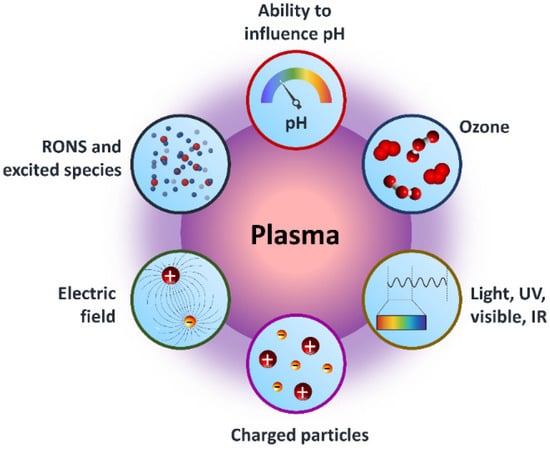
Figure 1. Graphical representation of core components of NTP for dealing with the surroundings in a variety of applications.
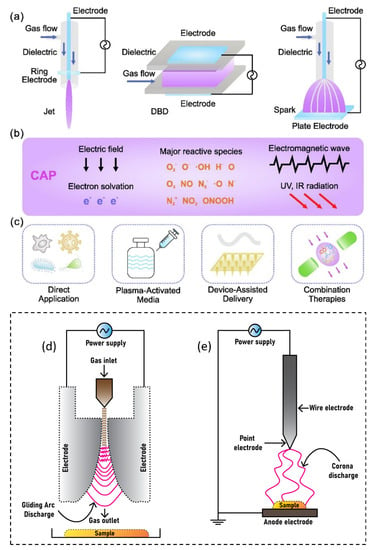
Figure 2. NTP delivery schematic for biomedical applications: (a) typical NTP devices, including plasma jet, DBD, and spark discharge; (b) plasma environment containing reactive species, electrons, other ions, emissions, waves, and physical forces; and (c) plasma delivery strategies, including direct application, plasma-activated media, device-assisted delivery, and therapeutic approaches. The most common devices used for environmental applications are (d) gliding arc discharge plasma and (e) corona discharge plasma.
1.1. Plasma
As plasma makes up 99% of the universe, it is the most prevalent kind of matter. The Sun and other stars, galaxies, solar winds, lightning, and the aurora borealis are all examples of the plasma state. Plasma televisions, neon and fluorescent lights, and plasma displays are well-known applications for man-made plasma. From Figure 1 and Figure 2c, it can be seen that plasma is made up of neutral, ionized, and/or excited charged particles, ions, and molecules, and ozone with the ability to influence the pH of solutions, as well as the existence of different ROS and RNS. A significant source of UV and vacuum UV radiation is plasma made up of several gases [24]. Plasma is a unique material treatment technology since it can employ a single component or a mix of components.
1.2. Thermal and Nonthermal Plasmas
All of the particles in a thermal plasma are at about the same temperature and completely ionized. Hot, completely ionized, and equilibrium plasma are other names for thermal plasma. Depending on the demands, equilibrium plasma is used in a variety of applications [25]. Plasma is a (partially) ionized gas made up of neutral species (molecules, radicals, excited species), ions, photons, and electrons. As the electron temperature is much higher than the temperature of heavy species (ions and neutrals) in nonthermal plasma (NTP) or non-equilibrium plasma, radicals and excited species are formed at temperatures that are closer to room temperature. This nonthermal energy distribution provides a potential route to getting around both the kinetic and thermodynamic constraints on the chemical conversion of reactants into desired products. Cold, partially ionized, atmospheric pressure, low temperature, and non-equilibrium plasma are other names for NTP. The NTP technology is suitable for treating a range of biological materials, including solids, liquids, and aerosols because it is at a low temperature when applied. There are several uses for two different types of NTP, low pressure and atmospheric pressure [26][27][28][29][26,27,28,29].
2. Generation of Reactive Species in NTP Discharge
The NTP is well recognized for generating exceptionally high concentrations of reactive species. NTP produces a variety of reactive oxygen species (ROS), including OH radicals, O2, H2O2, O, O3, and 1O2, as well as reactive nitrogen species (RNS), such as NO, NO2, N2O, N2O5, and atomic N [5]. Some of them, such as OH radicals, O, NO, N, and 1O2, have a short lifespan [19]. Helium plasma discharge was also applied by a number of studies [30][31][32][33][31,32,33,34]. The mechanisms by which ROS are produced in helium plasma jets have been well reported [34][35]. A number of species, including N2+, atomic (He, O) radicals, and molecular OH, were discovered in helium discharge [31][33][32,34]. The RONS, also referred to as primary reactive species, are generated by the energy released during collisions between accelerating electrons and neutrals. In the gas phase right after the collision, electrons (e−), ionized neutrals and gas (M+), excited neutrals and gas (M*), N, O, atomic H, NO, and O2*- are produced [13]. They are categorized as primary reactive species [35][36], and the intensities of these species are very high in the plasma region. The lifetimes of primary reactive species are relatively short; for example, the lifespan of OH radicals, NO, and O2*−, is 2.7 μs, 1.2 μs, 1.4 μs, and 1.3 μs, respectively [36][37]. Some of these reactive species immediately experience radiative decay, while others combine with neutrals, water molecules, and other reactive species. The main reactive species change into secondary reactive species such as H2O2, NO2, NO3, and O3 [37][38] in an ambient environment, as shown in Figure 3. The liquid phase (or another target) is where the RONS produced in the gas phase dissolve and form tertiary reactive species. The tertiary reactive species are formed when the RONS produced in the gas phase dissolve in the liquid phase [35][36]. Long-living reactive species include O3, H2O4, NO3, and NO2 because of their lifespans of a few milliseconds over several days [38][39]. Water can dissolve H2O2, NO2, and NO3; NO2 and NO3 are immediately converted into NO2− and NO3−, respectively [13][39][13,40]. Depending on the plasma source, working gas, power source, treatment time, and sample volume, these reactive species can reduce the pH of the target liquid by up to 2 [39][40]. However, whether a target is dry or aqueous affects the chemistry of ROS and RNS formation in a target [39][40]. The target, gas region, plasma/target interface, and discharge region of RONS formation are schematically depicted in Figure 3.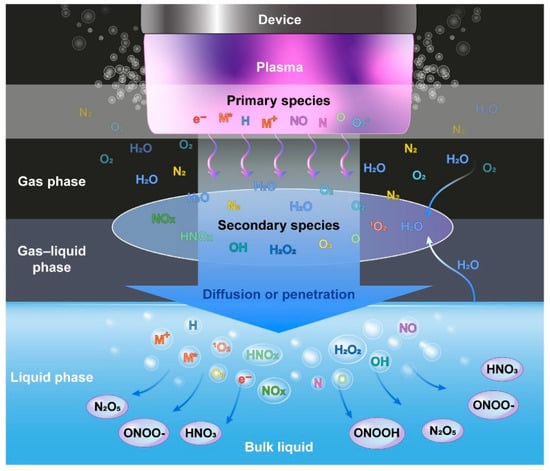
Figure 3. Graphical representation of formation of reactive species in plasma discharge, gas phase, gas–liquid phase, and liquid phase.
3. NTP Application for Cancer Treatment
The NTP technology has advanced dramatically in the previous two decades, from theoretical and experimental study to real-world implementations. The generation of plasma at atmospheric pressure and room temperatures to deal with biological systems has given rise to a new multidisciplinary field known as “plasma medicine” [2]. NTP has a variety of potentials in biomedical engineering nowadays [53][54]. Figure 4 depicts the interaction of NTP with the biological system, indicating the main molecular mechanisms involved in the use of LTP in cancer treatment. NTP technology has the potential to provide a less intrusive surgical procedure for removing particular cells without causing injury to the surrounding tissue. Traditional laser surgery relies on heat contact, which can result in unintentional cell death (necrosis) and lasting tissue damage. NTP contact with tissue, on the other hand, may allow selective cell elimination without necrosis [54][55]. Cell detachment without influencing cell viability, regulated cell death, and other interactions are examples of these interactions. It can also be employed for cosmetic approaches to dermis reticular architecture regeneration.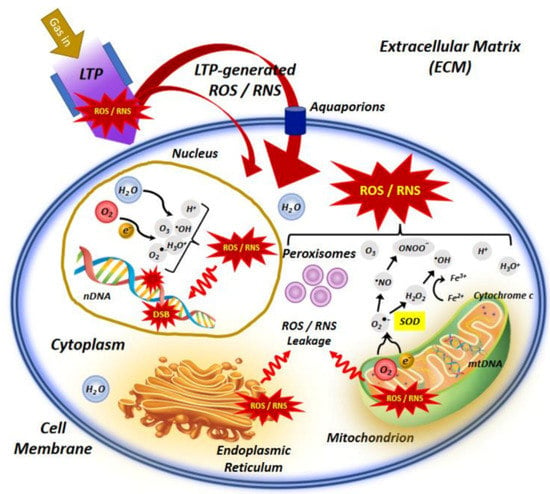
Figure 4. An illustration of the interaction of NTP or low−temperature plasma (LTP) with the cell, indicating the main molecular mechanisms involved in the use of LTP in cancer treatment.
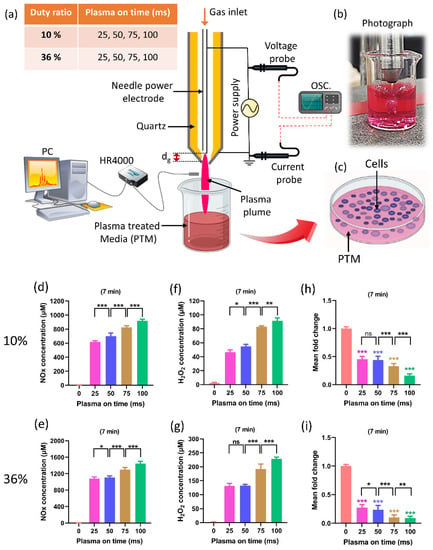
Figure 5. (a) The schematic of soft plasma jet and experimental setup. When preparing PTM, two fixed duty ratios of 10% and 36% were kept, as well as a fixed treatment time of 7 min; only the plasma on-time was changed (25, 50, 75, and 100 ms). (b) Photograph of soft jet during treatment, and (c) the application of PTM to the U87-MG cell line. (d,e) The NOx content in PTM by changing the plasma on-time when duty ratio (10% and 36%) and treatment time are fixed. (f,g) H2O2 content corresponding to plasma on-time in 10% and 36% duty ratio. (h,i) The cell viability by changing the plasma on-time. The NOx and H2O2 content significantly increased when only plasma on-time increased to 25, 50, 75, and 100 ms which shows further decline in the viability of brain cancer cells. The significance of treatment groups indicated by * p < 0.05, ** p < 0.01, *** p < 0.001, ns—not significant.
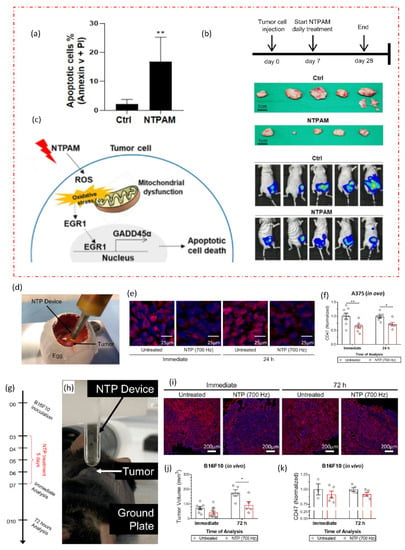
Figure 6. NTP applications in in vivo and in ovo studies. (a) The effects of nonthermal plasma-activated medium (NTPAM) on apoptosis in thyroid cancer (THCA) cells, which exhibit an increased percentage of apoptosis following NTPAM treatment. NTPAM has anticancer activity in an in vivo xenograft model. (b) Diagrammatic representation of the in vivo experimental plan. Following the injection of mice with FRO-Luc cells, final tumor images of cancer cells tracked with the IVIS imaging system, and last tumor images. (c) potential mechanism according to study, the THCA ROS/EGR1/GADD45α axis is induced by NTPAM. In an in ovo model, NTP treatment reduced CD47 expression in the A375 melanoma tumors. (d) Illustration of fertilized eggs that have been treated directly with NTP. Tumors were removed immediately after treatment or 24 h later, sectioned, and (e) stained with CD47 (red) and counterstained with DAPI (blue). (f) CD47 quantification was compared to untreated. In vivo, NTP treatment decreased tumor volume and marginally decreased CD47 expression. (g,h) Experimental design and NTP treatment directly for 5 days after developing B16F10 melanoma tumors in mice. (i) Tumors were removed either immediately after treatment or 72 h after treatment. (j) Following treatment, tumor volumes were also decreased. (k) CD47 quantification. The significance of treatment groups indicated by * p < 0.05, ** p < 0.01, ns—not significant.
4. Role of Plasma Technology in Food Decontamination and Storage
4.1. Microbial Inactivation
Plasma technology’s source of ROS and RNS is mainly concerned with increasing the yields of cultivars by stimulating seedling growth and inactivating microorganisms to increase the shelf life of food storage and fulfill the scarcity of food from all over the world [68][69][90,91]. Several treatment methods increased the concentration of intrabacterial reactive species such as H2O2, NO3, NO2, and O3. These reactive species are caused by oxidative stress, which prevented the ability of biofilms to regenerate [70][92]. The inactivation of E. coli bacteria was reported due to the UV radiation produced during the PAW [71][93]. The PAW has bactericidal properties due to the RONS. Conidium is an asexually generated fungal spore, a notorious plant disease inhibited by the reactive species in the PAW [72][94]. Most crops are destroyed by serious diseases by wall-less bacteria called phytoplasmas. Yellow grapevines can easily become infected with phytoplasma [73][95]. Phytoplasma caused disease in yellow grapevines controlled by the plasma-treated liquids which stimulate the defensive enzymes stilbene synthase and phenylalanine ammonia. The presence of RONS in PAW solution results in oxidative stress, which activates the stilbene metabolic pathway and increases the antioxidant properties. Resultantly, the research shows that PAW treatment can be used to enhance plants’ resistance to diseases [74][96].4.2. Effect of NTP on Biofilms
Biofilms are multicellular communities of microbial cells, connected to a surface indefinitely and enveloped by a matrix predominantly consisting of polysaccharides, extracellular nucleic acid, and protein. In nature, more than 95% of the bacteria exist as a biofilm which favors their growth on solid surfaces [75][97]. Bacterial biofilm formation involves many steps. Quorum sensing is a special type of signaling required which occurs between microbial cells, and the transcription of a different set of genes is also a basic requirement for biofilm formation. Bacterial inactivation or bio-decontamination, as well as the sterilization of surfaces by NTP, have gained a lot of interest in recent years [76][98]. It is well-known that NTP has antibacterial effectivity and can inactivate planktonic bacteria, yeast, and spores. The effects of plasma application on biofilms seem to be a promising new direction in biofilm removal technology [77][99]. Since NTP, particularly atmospheric-pressure plasma jets (APPJs), are frequently operated at temperatures close to room temperature, they can be used directly on heat-sensitive materials such as human tissues. Due to the APPJs’ transitory character and accompanying thermal non-equilibrium, the plasma chemistry is improved, and charged species are transported to the targets quickly and efficiently [78][100]. The reactive species formed by plasmas are expected to comprise a combination of charged particles and chemically active species producing ultraviolet (UV) light (e.g., O3, O2, NO, H2O2, and OH) which contribute to the anti-microbial effects by inflicting damage on DNA, lipids, proteins, etc., leading to cellular structure degradation [79][101]. BAs we know, bacterial biofilms consist of DNA, proteins, and polysaccharides which are affected or damaged by plasma-generated reactive species which are made up of charged particles and chemically active species and the generation of UV radiation.4.3. Sustaining Food Freshness and Storage
NTP technology has been suggested as an advanced method to increase food freshness and food storage for longer use. The freshness of freshly cut lettuce was reported to be maintained for a long time after washing with PAW. The lettuce tissue organelles were sustained as fresh properties such as color, texture, and taste after washing with PAW treatment [80][81][102,103]. PAW treatment has the ability to maintain the freshness of fresh-cut kiwifruit. Kiwifruits were sprayed with PAW solution or deionized water and submerged in S. aureus suspension. The reactive species in PAW generated oxidative stress, which in turn damaged the membrane of bacterial cells and ultimately lead to cell death. Furthermore, PAW treatment had no detrimental effects on the kiwifruits’ quality. They were less affected by reactive species oxidative species damage due to the antioxidant enzymes in PAW [82][104]. Plasma therapy effectively suppressed B. cinerea spore germination and mycelial development in vitro, as well as gray mold decomposition in blueberries infected with B. cinerea during postharvest storage [83][105]. Figure 7 shows the action of NTP on bacterial cell structures, resulting in functional loss and sterilization which helps in food preservation.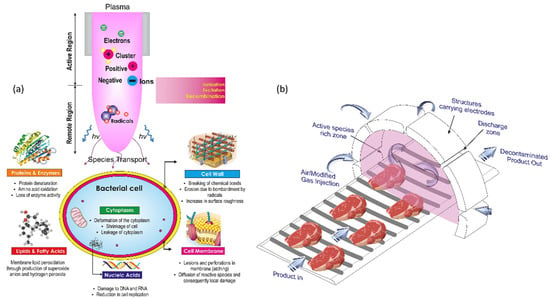
Figure 7. (a) A diagram depicting the action of NTP on bacterial cell structures, resulting in functional loss and sterilization. (b) Conceptual model for an industrial-level continuous NTP disinfecting unit.
